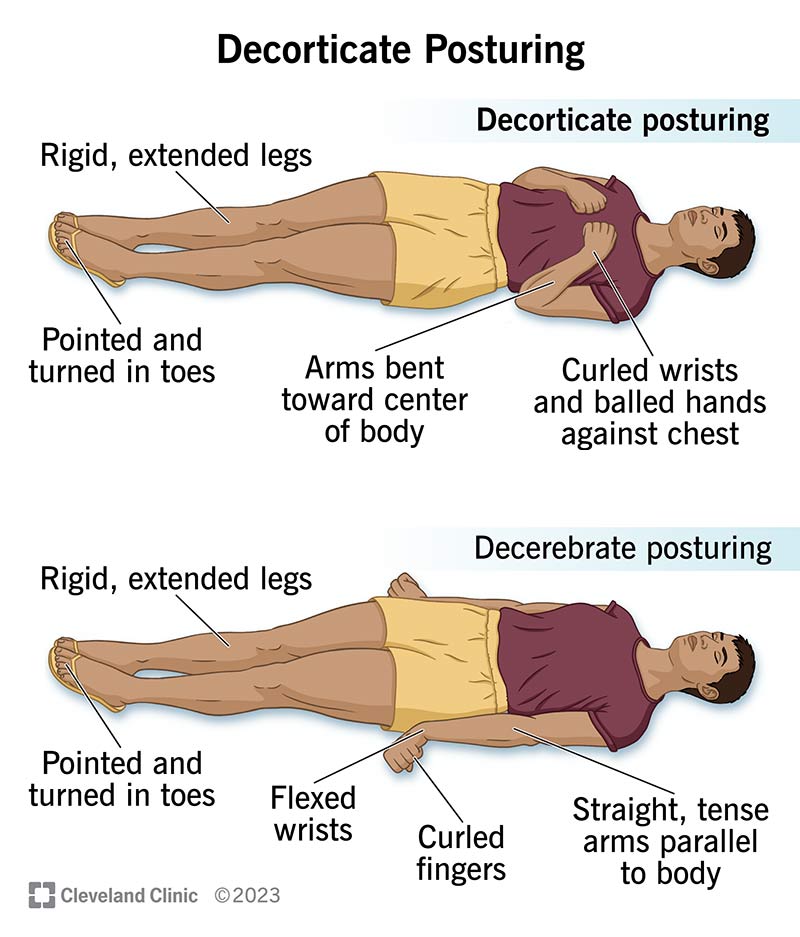Decorticate posturing is a reflex pose that’s a symptom of damage to or disruptions in brain activity. It causes your legs to become rigid and straight, while your arms flex upward and hold tensely to your chest. It’s usually a sign of brain damage or disrupted brain activity.
Advertisement
Cleveland Clinic is a non-profit academic medical center. Advertising on our site helps support our mission. We do not endorse non-Cleveland Clinic products or services. Policy

Decorticate posturing is a pose that your body may hold automatically because of damage to or disruptions in your brain. It’s a symptom of brain injuries and many different medical conditions.
Advertisement
Cleveland Clinic is a non-profit academic medical center. Advertising on our site helps support our mission. We do not endorse non-Cleveland Clinic products or services. Policy
Decorticate posturing causes certain muscle groups throughout your body to reflexively tense up. It can affect one side of the body or both. However, when it affects both sides, it isn’t always consistent. It may affect both sides of the body unevenly.
Decorticate posturing is a reflex. The movements it involves aren’t like the uncontrolled movements of a seizure. Instead, it’s usually a response to uncomfortable sensations (which is part of testing reflexes in a neurological exam).
A person with decorticate posturing can have the following:
Decorticate posturing is one of the indicators that healthcare providers use when assessing coma using the Glasgow Coma Scale. People who have this are always unconscious and unresponsive. That means they don’t wake up or respond, even with repeated efforts to rouse them.
Having decorticate posturing often indicates problems or damage in certain brain areas. Some of the areas it can involve are:
Advertisement
Conditions that can cause decorticate posturing include (but aren’t limited to) the following:
Decorticate posturing is a symptom that isn’t treatable directly. However, treating a condition that’s causing it may be possible.
In addition to treating the underlying cause, there are other likely forms of care that a person with decorticate posturing may receive. People with this symptom are unconscious or in a coma and may need supportive treatment. An example of supportive treatment is mechanical ventilation to help them breathe.
Because there are so many possible causes, the treatment options can vary. A healthcare provider is the best person to tell you about treatment options and which ones they recommend.
Decorticate posturing is usually a sign of damage to the brain or severe disruptions in brain activity. Many of the conditions that cause it are deadly without treatment. Delays in treatment can also result in permanent damage. When permanent damage happens, the abilities once controlled by the damaged areas may be severely disrupted or permanently lost.
Many causes of decorticate posturing are preventable. Some happen unpredictably or for reasons experts don’t fully understand, so preventing this symptom isn’t always possible. However, there are some things you can do to lower your risk of developing conditions that can lead to decorticate posturing.
Steps you can take include:
Advertisement
A person with uncontrolled muscle movements of any kind when unconscious and unresponsive (meaning they don’t wake up when you try to rouse them) needs immediate medical care. Call 911 (or your local emergency services number) right away.
Decorticate posturing and decerebrate posturing look very much alike. A trained healthcare provider should be the one to diagnose either of them. Even trained, experienced clinicians may find it challenging to diagnose them.
Generally, decorticate posturing is less severe than decerebrate posturing. The main difference between the two postures is whether or not the arms are bent at the elbow. A person whose elbows bend and fold their arms up toward their chest has decorticate posturing. A person whose limbs all extend away from their head has decerebrate posturing.
Many of the conditions that cause decorticate posturing are treatable or reversible, especially conditions like hypoglycemia. The underlying cause is one of the biggest factors when determining the odds of survival and recovery.
Having a loved one who has decorticate posturing can be a frightening experience. People who have this are unconscious and in a coma. This symptom is a key indicator of conditions that damage the brain or disrupt brain processes.
Advertisement
However, this symptom doesn’t mean there’s no hope for survival or recovery. Modern medical advances mean that treatment options are possible for many brain conditions that can cause decorticate posturing. The odds are ever-improving, and there’s hope for many people with this symptom now and in the future.
Advertisement
If you have a neurological condition, you want expert advice. At Cleveland Clinic, we’ll work to create a treatment plan that’s right for you.

Last reviewed on 05/09/2023.
Learn more about the Health Library and our editorial process.